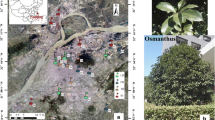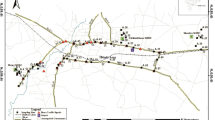Abstract
This is a report on magnetic properties of highroad-side tree (Pinus pumila Regel) leaves collected along an expressway linking Beijing City and the Capital International Airport and further focus on their environmental contributions. A series of rock magnetic experiments show that the primary magnetic mineral of leaf samples was identified to be magnetite, in the pseudo-single domain (PSD) grain size range 0.2–5.0 μm. On the other hand, magnetite concentration and grain size in leaves are ascertained to decrease with increasing of sampling distance to highroad asphalt surface, suggesting that high magnetic response to traffic pollution is localized within a distance of some two meters away from highroad asphalt surface. Although magnetic susceptibility is ordinarily regarded as a simple, rapid and low-cost method for monitoring traffic pollution, saturation isothermal remanent magnetization (SIRM) can be treated as a valid proxy for monitoring air particulate matter (PM) when samples are magnetically weak. It is believed that a synthetic rock magnetic study is an effective method for determining concentration and grain size of ferromagnets in the atmospheric PM, and then it should be a rapid and feasible technique for monitoring atmospheric pollution.
Similar content being viewed by others
References
Liao J F. The affects of urbanization to soil environment. Ecol Sci, 2001, 20(1, 2): 91–95
Pope C A, Thun M J, Namboodiri, M M, et al. Particulate air pollution as a predictor of mortality in a prospective study of US adults. Am J Respiration and Critical Care Medicine, 1995, 151: 669–674
Zhang G L, Zhu Y G, Fu B J. Quality changes of soils in urban and suburban areas and its eco-environmental impacts—A review. Actaecol Sin, 2003, 23(3): 539–546
Hunt A., Jones J, Oldfield F. Magnetic measurements and heavy metals in atmospheric particulates of anthropogenic origin. Sci Total Environ, 1984, 33: 129–139
Schädlich G, Werssflog L, Schüürmann G. Magnetic susceptibility in conifer as indicator of fly ash deposition. Fresenius Environ Bull, 1995, 4: 7–12
Hoffmann V, Knab M, Appel E. Magnetic susceptibility mapping of roadside pollution. J Geochem Explor, 1999, 66: 313–326
Gautam P, Blaha U, Appel E, et al. Environmental magnetic approach towards the quantification of pollution in Kathmandu urban area, Nepal. Phys Chem Earth, 2004, 29: 973–984
Zhang W G, Yu L Z, Magnetic properties of tidal flat sediments of the Yangtze Estuary and its relationship with particle size. Sci China Ser D-Earth Sci, 2003, 46(9): 954–966
Ju Y T, Wang S H, Deng C L. Mineral magnetic properties of polluted topsoils: a case study in Sanming city, Fujian province, southeast China. Chinese J Geophys, 2004, 29: 973–984
Morris W A, Versteeg J K, Bryant D W, et al. Preliminary comparisons between mutagenicity and magnetic susceptibility of respirable airborne particulate. Atmos Environ, 1995, 29: 3441–3450
Shu J, Dearing J A, Morse A P, et al. Determining the sources of atmospheric particles in Shanghai, China, from magnetic and geochemical properties. Atmos Environ, 2001, 35: 2615–2625
Muxworthy A R, Matzka J, Petersen N. Comparison of magnetic parameters of urban atmospheric particulate matter with pollution and meteorological data. Atmos Environ, 2001, 35: 4379–4386
Muxworthy A R, Matzka J, Davila A F, et al. Magnetic signature of daily sampled urban atmospheric particles. Atmos Environ, 2003, 37: 4163–4169.
Urbat M, Lehndorff E, Schwark L. Biomonitoring of air quality in the Cologne conurbation using pin needles as a passive sampler—Part I: magnetic properties. Atmos Environ, 2004, 38: 3781–3792
Hanesch M, Scholger R, Ray D. Mapping dust distribution around an industrial site by measuring magnetic parameters of tree leaves. Atmos Environ, 2003, 37: 5125–5133
Flanders P J. Collection, measurement and analysis of airborne magnetic particulates from pollution in the environment. J Appl Phys, 1994, 75: 5931–5936
Goddu S R, Appel E, Jordanova D, et al. Magnetic properties of road dust from Visakhapatnam (India)—Relationship to industrial pollution and road traffic. Phys Chem Earth, 2004, 29: 985–995
Matzka J, Maher B A. Magnetic biomonitoring of roadside tree leaves: identification of spatial and temporal variations in vehicle—derived particulates. Atmos Environ, 1999, 33: 4565–4569
Moreno E, Sagnotti L, Dinarès T J, et al. Biomonitoring of traffic air pollution in Rome using magnetic properties of tree leaves. Atmos Environ, 2003, 37: 2967–2977
Özdemir Ö, Dunlop D J, Moskowitz B M. Changes in remanence, coercivity and domain state at low temperature in magnetite. Earth Planet Sci Lett, 2002, 194: 343–358
King J G, Williams W. Low-temperature magnetic properties of magnetite. J Geophys Res, 2000, 105:16427–16436
Dankers P. Relationship between median destructive field and remanent coercive force for dispersed natural magnetite, titanomagnetite and hematite. Geophys J Res, 1981, 64: 447–461
Day R, Fuller M, Schmid V A. Hysteresis properties of titanomagnetites: grain size and compositional dependence. Phys Earth Int, 1977, 13: 260–267
Dunlop D J. Theory and application of the Day plot (Mrs/Ms versus Hcr/Hc) 1. Theoretical curves and test using titanomagnetite data. J Geophys Res, 2002, 107(B3): 10.1029/2001JB000486
Dunlop D J, Özdemir Ö. Rock Magnetism: Fundamentals and Frontiers. Cambridge: Cambridge University Press, 1997. 262–287
King J, Banerjee S K, Marvin J, et al. A comparison of different magnetic methods of determining the relative grain size of magnetite in natural materials: some results from lake sediments. Earth Planet Sci Lett, 1982, 59: 404–419
Kenneth L, Veerosub, Andrew, P. R. Environmental magnetism: past, present, and future. J Geophys Res, 1995, 100: 2175–2192
Oldfield F. Environmental magnetism—A personal perspective. Quaternary Sci Rev, 1991, 10:73–85
Heider F, Zitzelsoberger A, Fabian K. Magnetic susceptibility and remanent coercive force in grown magnetite crystals from 0.1 μm to 6mm. Phys Earth Planet Interiors, 1996, 93: 239–256
Zhang C X, Huang B C. The application and research progress of environmental magnetism in monitoring urban environment pollution. Progress Geophys, 2005, 20(3):705–711
Özdemir Ö, Dunlop D J, Moskowitz B M. The effect of oxidation on the verway transition in magnetite. Geophys Res Lett, 1993, 20:1671–1674
Fukuma K, Torii M. Variable shape of magnetic hysteresis loops in the Chinese loess—Paleosol sequence. Earth Planets Space Lett, 1998, 50: 9–14
Guo B, Zhu R X, Bai L X, et al. Rock magnetic properties of a loess/palaeosol couple along an N-S transect in Chinese Loess Plateau. Sci China Ser D-Earth Sci, 2001, 44(12): 1099–1109
Barbara A. Magnetic properties of modern soils and Quaternary loessic paleosols: paleoclinatic implications. Palaeogeog Paleoclimat Palaeoecol, 1998, 137: 25–54
Author information
Authors and Affiliations
Corresponding author
About this article
Cite this article
Zhang, C., Huang, B., Li, Z. et al. Magnetic properties of high-road-side pine tree leaves in Beijing and their environmental significance. CHINESE SCI BULL 51, 3041–3052 (2006). https://doi.org/10.1007/s11434-006-2189-7
Received:
Accepted:
Issue Date:
DOI: https://doi.org/10.1007/s11434-006-2189-7




